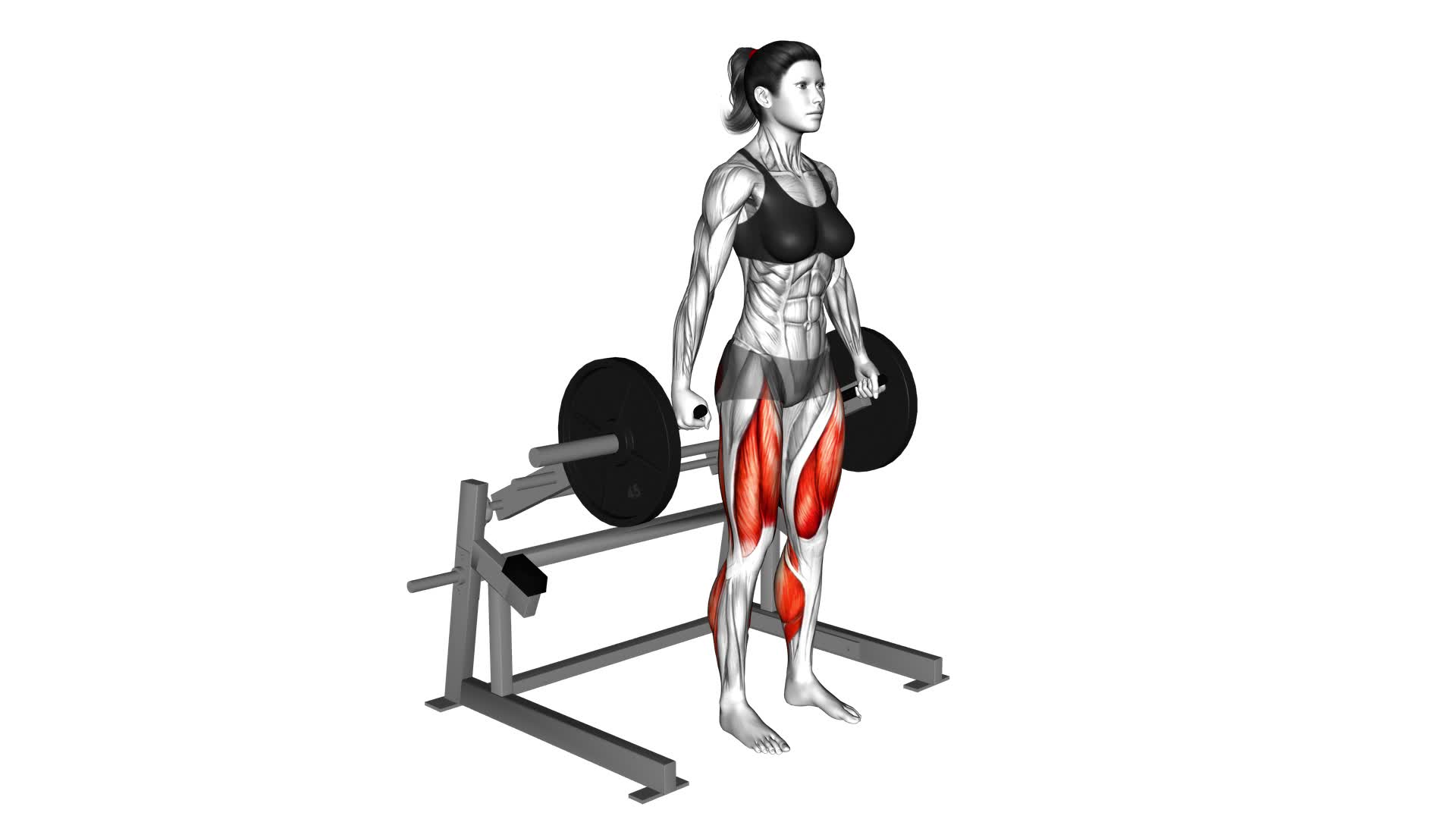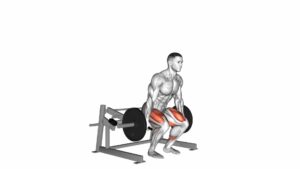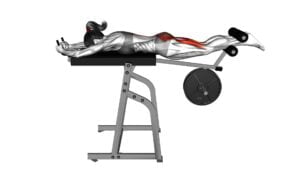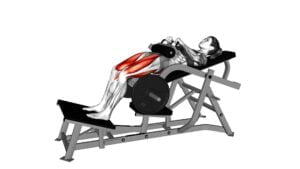Lever Deadlift (Plate Loaded) (Female) – Video Exercise Guide & Tips

Are you looking to master the lever deadlift? This video exercise guide and tips article is here to help!
Watch This Exercise Video
Discover the benefits of this powerful exercise for women, learn proper form and technique, and find out how to choose the right weight.
Avoid common mistakes, explore variations and modifications, and get expert tips for progressing and increasing weight.
Get ready to take your lever deadlift to the next level!
Key Takeaways
- Lever deadlifts provide numerous benefits for women, including increased strength, improved posture, enhanced overall body composition, and the ability to target multiple muscle groups simultaneously.
- Proper form and technique for lever deadlifts involve gripping the handles of the lever, planting the feet firmly on the ground, engaging the core, and driving through the heels to lift the lever.
- Lever deadlifts offer a more controlled and stable lifting motion compared to traditional deadlifts, making them beneficial for individuals with limited mobility or lower back issues.
- Lever deadlifts place more emphasis on posterior chain muscles, offer a more targeted and isolated movement than compound exercises, and can be a suitable alternative or complement to other lower body exercises depending on fitness goals and individual needs.
Benefits of Lever Deadlift for Women
Experience the numerous benefits of lever deadlifts for women, including increased strength, improved posture, and enhanced overall body composition.
Lever deadlifts are a highly effective exercise that target multiple muscle groups simultaneously, making them a great addition to any woman's fitness routine.
One of the key benefits of lever deadlifts for women is the increase in strength that they provide. By engaging the muscles in the lower body, including the glutes, hamstrings, and quadriceps, lever deadlifts help to build overall strength and power. This can have a positive impact on everyday activities such as lifting heavy objects or performing physical tasks.
In addition to increased strength, lever deadlifts also contribute to improved posture. As women often have a tendency to slouch or have rounded shoulders, incorporating lever deadlifts into their workout routine can help to strengthen the muscles in the upper back, promoting better posture and reducing the risk of back pain.
Furthermore, lever deadlifts can greatly enhance overall body composition. By engaging large muscle groups, they help to burn calories and increase lean muscle mass. This can lead to a more toned and defined physique, as well as a higher metabolic rate, which aids in weight management.
Proper Form and Technique for Lever Deadlift
To perform the lever deadlift with proper form and technique, you should start by gripping the handles of the lever and firmly planting your feet on the ground. Here's a step-by-step guide to help you execute the exercise correctly:
- Set up the lever: Position yourself in front of the lever with your feet shoulder-width apart. Bend your knees and hips to lower your body and grasp the handles with an overhand grip.
- Engage your core: Before lifting, engage your core by bracing your abs and pulling your shoulder blades back and down. This will help stabilize your spine and protect your lower back.
- Lift the lever: Drive through your heels, extend your hips, and lift the lever by pushing your hips forward. Keep your back straight and maintain a neutral spine throughout the movement.
- Lower the lever: Slowly lower the lever back down to the starting position by bending your hips and knees. Keep your core engaged and control the descent to prevent any sudden movements.
When comparing the lever deadlift to traditional deadlifts, there are a few key differences to consider. The lever deadlift:
- Provides a more controlled and stable lifting motion due to the lever arm and handles.
- Can be beneficial for individuals with limited mobility or lower back issues, as it places less stress on the lower back.
- Targets similar muscle groups as traditional deadlifts, such as the glutes, hamstrings, and lower back.
In contrast, when compared to other lower body exercises, the lever deadlift:
- Places more emphasis on the posterior chain muscles, making it an effective exercise for strengthening the hips and hamstrings.
- Offers a more targeted and isolated movement than compound exercises like squats or lunges.
- Can be a suitable alternative or complement to other lower body exercises, depending on your fitness goals and individual needs.
Choosing the Right Weight for Lever Deadlift
How can you determine the appropriate weight for the lever deadlift?
When it comes to weight selection for the lever deadlift, it's crucial to find a weight that challenges you but also allows you to maintain proper form and technique. Progression is key, so it's important to start with a weight that you can comfortably lift for a few sets and gradually increase the weight over time.
To determine the right weight for your lever deadlift, consider your current strength level and experience. If you're a beginner, it's recommended to start with a lighter weight to focus on mastering the technique and building a solid foundation. As you become more comfortable and confident, you can gradually increase the weight to continue challenging yourself.
Another approach to weight selection is to use a percentage of your one-rep maximum (1RM). Start with a weight that's around 50-60% of your 1RM and gradually increase it as you progress. This allows you to track your progress and ensure that you're constantly challenging yourself without overexerting.
Common Mistakes to Avoid in Lever Deadlift
To ensure proper form and technique in the lever deadlift, it's important to be aware of common mistakes to avoid. By avoiding these mistakes, you can reduce the risk of injury and improve your strength effectively. Here are four common mistakes to steer clear of:
- Rounding your back: One of the most crucial aspects of the lever deadlift is maintaining a neutral spine. Avoid rounding your back, as this can put excessive stress on your lower back and increase the chances of injury. Focus on keeping your back straight throughout the movement.
- Using too much weight: While it's important to challenge yourself, using too much weight can compromise your form and increase the risk of injury. Start with a weight that allows you to maintain proper technique and gradually increase the load as your strength improves.
- Neglecting the hip hinge: The lever deadlift is a hip-dominant exercise that requires a proper hip hinge movement. Avoid relying solely on your lower back or squatting too much. Instead, focus on hinging at the hips and driving through your heels to engage your glutes and hamstrings effectively.
- Jerking the weight: Smooth and controlled movements are key in the lever deadlift. Avoid jerking the weight up or dropping it abruptly, as this can strain your muscles and joints. Instead, focus on a controlled lifting and lowering motion.
By avoiding these common mistakes, you can maximize the benefits of the lever deadlift while minimizing the risk of injury.
Now, let's dive into the next section to explore variations and modifications for the lever deadlift.
Variations and Modifications for Lever Deadlift
Now let's explore some variations and modifications you can incorporate into your lever deadlift routine to target different muscle groups and add variety to your workouts.
One modification you can make is to change the grip you use. Instead of using an overhand grip, try using an underhand grip or a mixed grip (one hand overhand, one hand underhand) to engage different muscles in your arms and back.
Another modification is to vary the height of the barbell. You can perform the lever deadlift from a deficit by standing on a platform or step, which increases the range of motion and puts more emphasis on your hamstrings and glutes. On the other hand, you can perform the exercise from an elevated position by placing blocks or plates under the barbell, which targets your quadriceps and lower back more.
Additionally, you can use different equipment to modify the lever deadlift. For example, using a trap bar instead of a barbell allows for a more natural grip and places less strain on your lower back. Resistance bands can also be incorporated to add extra resistance and challenge your muscles in different ways.
Tips for Progressing and Increasing Weight in Lever Deadlift
To progress and increase the weight in your lever deadlift, you can gradually add more weight to the barbell as your strength and technique improve.
Here are some helpful tips to guide you in your progression:
- Start with proper form: Before increasing the weight, ensure that you have mastered the correct technique for the lever deadlift. This will help prevent injuries and allow you to lift heavier weights safely.
- Gradually increase the weight: Instead of adding a significant amount of weight all at once, make small incremental increases. This will allow your muscles to adapt and grow stronger over time.
- Focus on progressive overload: To continue making progress, aim to gradually increase the weight lifted over weeks or months. This progressive overload stimulates muscle growth and strength gains.
- Listen to your body: Pay attention to how your body feels during and after each session. If you're consistently struggling with a certain weight, it may be a sign that you need to hold off on increasing the weight and focus on improving your technique or building more strength.
Frequently Asked Questions
How Does the Lever Deadlift Compare to Other Types of Deadlift Exercises?
The lever deadlift is a variation of the traditional deadlift exercise that you can compare to other types of deadlifts. It offers unique benefits, especially for women.
By using a lever and plate-loaded system, this exercise allows you to focus on proper form and target specific muscle groups.
It can help improve overall strength, build muscle mass, and enhance your lifting technique.
Incorporating the lever deadlift into your workout routine can be a valuable addition for women looking to challenge themselves and achieve their fitness goals.
Can Lever Deadlifts Help Improve Overall Strength and Muscle Tone in Women?
Lever deadlifts are a great exercise for improving overall strength and muscle tone in women. They offer variations for different fitness levels, allowing you to progress at your own pace.
By engaging multiple muscle groups, lever deadlifts help you build strength in your legs, glutes, and back. This exercise also promotes better posture and core stability.
Incorporating lever deadlifts into your workout routine can lead to noticeable improvements in your overall strength and muscle tone.
Are There Any Specific Muscle Groups That the Lever Deadlift Targets?
The lever deadlift is a great exercise for targeting specific muscle groups. It engages your glutes, hamstrings, quadriceps, and lower back. By incorporating this exercise into your routine, you can improve overall strength and muscle tone in these areas.
Not only that, but it also provides numerous benefits for women. So, if you're looking to target specific muscle groups and enhance your overall fitness, the lever deadlift is definitely worth considering.
Is It Necessary to Use a Specific Type of Lever Machine for the Lever Deadlift Exercise?
To answer your question, using a specific type of lever machine for the lever deadlift exercise isn't necessary.
However, there are different lever deadlift variations that you can perform using various machines.
The benefits of using a lever machine include providing stability and support during the exercise, allowing you to focus on proper form and technique.
It also helps in targeting specific muscle groups, such as the glutes, hamstrings, and lower back.
Can Lever Deadlifts Be Modified for Women With Certain Physical Limitations or Injuries?
Lever deadlifts can definitely be modified for women with certain physical limitations or injuries. Depending on the specific limitations, you can adjust the weight, range of motion, or use alternative equipment like resistance bands. These modifications ensure that you can still reap the benefits of lever deadlifts, such as strengthening your lower body, improving posture, and increasing overall strength.
It's important to consult with a fitness professional to determine the best modifications for your individual needs.
Conclusion
In conclusion, the lever deadlift is a beneficial exercise for women, providing numerous advantages such as improved strength and muscle definition. By maintaining proper form and technique, choosing the appropriate weight, and avoiding common mistakes, women can effectively perform this exercise.
Additionally, variations and modifications can be incorporated to cater to individual fitness levels and goals. With these tips and progressions, women can continue to increase their weight and challenge themselves in the lever deadlift.

Author
Years ago, the spark of my life’s passion ignited in my mind the moment I stepped into the local gym for the first time. The inaugural bead of perspiration, the initial endeavor, the very first surge of endorphins, and a sense of pride that washed over me post-workout marked the beginning of my deep-seated interest in strength sports, fitness, and sports nutrition. This very curiosity blossomed rapidly into a profound fascination, propelling me to earn a Master’s degree in Physical Education from the Academy of Physical Education in Krakow, followed by a Sports Manager diploma from the Jagiellonian University. My journey of growth led me to gain more specialized qualifications, such as being a certified personal trainer with a focus on sports dietetics, a lifeguard, and an instructor for wellness and corrective gymnastics. Theoretical knowledge paired seamlessly with practical experience, reinforcing my belief that the transformation of individuals under my guidance was also a reflection of my personal growth. This belief holds true even today. Each day, I strive to push the boundaries and explore new realms. These realms gently elevate me to greater heights. The unique combination of passion for my field and the continuous quest for growth fuels my drive to break new ground.







